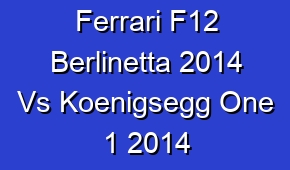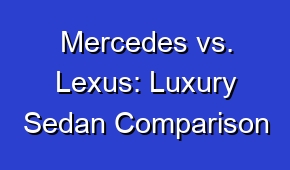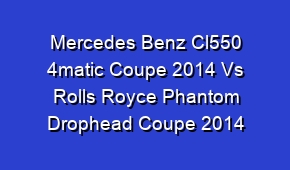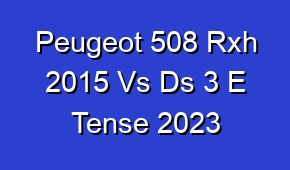Bugatti Veyron 16 4 Grand Sport 2013 Vs Ferrari Ff 2014

Compare the Bugatti Veyron 16 4 Grand Sport 2013 and the Ferrari Ff 2014 to find out which of these luxury sports cars reigns supreme. Discover their performance, features, and design elements in this head-to-head showdown.
| Feature | Bugatti Veyron 16.4 Grand Sport 2013 | Ferrari FF 2014 |
|---|---|---|
| Engine | 8.0L W16 | 6.3L V12 |
| Horsepower | 1001 hp | 651 hp |
| Top Speed | 253 mph (407 km/h) | 208 mph (335 km/h) |
| Acceleration (0-60 mph) | 2.4 seconds | 3.7 seconds |
| Transmission | 7-speed dual-clutch | 7-speed dual-clutch |
| Drive Type | All-wheel drive | All-wheel drive |
| Seating Capacity | 2 | 4 |
| Weight | 4,387 lbs (1,990 kg) | 4,145 lbs (1,880 kg) |
| Fuel Efficiency (Combined) | 14 mpg (6.7 L/100km) | 15 mpg (15.7 L/100km) |
| Length | 175.7 in (4462 mm) | 193.2 in (4907 mm) |
| Width | 78.7 in (1999 mm) | 76.4 in (1941 mm) |
| Height | 47.4 in (1204 mm) | 54.3 in (1379 mm) |
| Wheelbase | 106.7 in (2710 mm) | 117.7 in (2990 mm) |
| Front Suspension | Double wishbone | Double wishbone |
| Rear Suspension | Double wishbone | Multi-link |
| Brakes (Front) | Carbon ceramic | Carbon ceramic |
| Brakes (Rear) | Carbon ceramic | Carbon ceramic |
Engine
The Bugatti Veyron 16.4 Grand Sport 2013 is equipped with an impressive 8.0L W16 engine, while the Ferrari FF 2014 features a 6.3L V12 engine. Both engines offer exceptional power and performance.
Horsepower
The Bugatti Veyron takes the lead in terms of horsepower, boasting an incredible 1001 hp, while the Ferrari FF offers 651 hp. The Veyron’s higher horsepower contributes to its exceptional speed and acceleration.
Top Speed
The Bugatti Veyron holds the title for the fastest top speed, reaching an impressive 253 mph (407 km/h). The Ferrari FF, on the other hand, has a top speed of 208 mph (335 km/h). The Veyron’s higher top speed is a testament to its exceptional engineering and aerodynamics.
Acceleration (0-60 mph)
The Bugatti Veyron outperforms the Ferrari FF in terms of acceleration, achieving 0-60 mph in just 2.4 seconds. The Ferrari FF takes 3.7 seconds to reach the same speed. The Veyron’s lightning-fast acceleration is a result of its powerful engine and advanced transmission system.
Transmission
Both the Bugatti Veyron and the Ferrari FF are equipped with a 7-speed dual-clutch transmission. This type of transmission allows for quick and seamless gear changes, enhancing the overall driving experience and performance of both vehicles.
Drive Type
Both the Bugatti Veyron and the Ferrari FF feature an all-wheel drive system. This type of drivetrain provides enhanced traction and stability, particularly in challenging driving conditions. It contributes to the overall handling and performance of both vehicles.
Seating Capacity
The Bugatti Veyron has a seating capacity of 2, while the Ferrari FF can accommodate up to 4 passengers. The Ferrari FF offers additional seating space, making it more suitable for those who require seating for more passengers or prefer a more practical option.
Weight
The Bugatti Veyron weighs 4,387 lbs (1,990 kg), while the Ferrari FF weighs 4,145 lbs (1,880 kg). Despite their substantial weight, both vehicles are designed to deliver exceptional performance and handling capabilities.
Fuel Efficiency (Combined)
The Bugatti Veyron has a combined fuel efficiency of 14 mpg (6.7 L/100km), while the Ferrari FF offers slightly better fuel efficiency with 15 mpg (15.7 L/100km). However, it’s important to note that these vehicles prioritize performance over fuel efficiency.
Dimensions
The Bugatti Veyron measures 175.7 inches (4462 mm) in length, 78.7 inches (1999 mm) in width, and 47.4 inches (1204 mm) in height. The Ferrari FF, on the other hand, is larger, measuring 193.2 inches (4907 mm) in length, 76.4 inches (1941 mm) in width, and 54.3 inches (1379 mm) in height. The Ferrari FF offers more interior space and a slightly larger footprint.
Suspension and Brakes
Both the Bugatti Veyron and the Ferrari FF feature advanced suspension systems. The Veyron is equipped with double wishbone suspension at the front and rear, while the Ferrari FF has double wishbone suspension at the front and multi-link suspension at the rear. Additionally, both vehicles are equipped with carbon ceramic brakes, providing exceptional stopping power and performance.





















